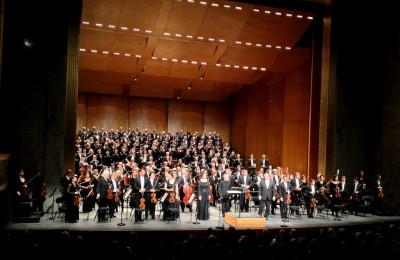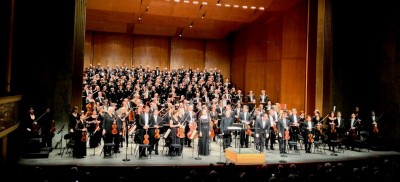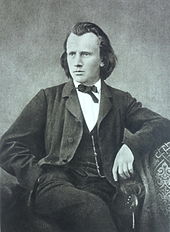Brilliant choire job in “Ein Deutsches Requiem” at Theatre Champs Elysees

Johannes Brahms “Ein Deutsches Requiem with Orchestre National de France and Choire de Radio France, conducted by Christoph Eschenbach
. Photo from the applause Tomas Bagackas.
PARIS: The choire is playing the main role in “Ein Deutsches Requiem” by Johannes Brahms at Theatre des Champs Elysees with Orchestre National de France, and they did a great job, so it became a hit in the Easter Periode, – (and also the rest of the year)
. Conducted by Christoph Eschenbach.
Review by Henning Høholt, photo from applause Tomas Bagackas
A completely full hall at Théâtre des Champs Élysées, even in the small boxes at the top tells that this Requiem is among the popular choire works
. It is the choire who is playing the leading role, and they are nearly singing all the time during the more than 75 minutes which this version became. Only two times it is the baryton, which was sung with a beautifuk feeling in the voice by the world famouse Matthias Goerne, in this he was axcellent. And one soprano aria sung by Ruth Ziesak, so the choire could get a welcome short break, before they ended up her aria together. Even that ms. Ziesak was not pressing her voice it became a bit screaming to me, and I was not feeling well with her voice in her part
– if patient is on nitrate therapy, stopExtremely cialis.
.
The opening part “Selig sind, die da Leid tragen” (Matthäus 5,4) presented a great choire sound, good harmony in the four different groups, and in the balance between them. And it continued like that through all the requiem, clear diction, even that it is a large choire, they have done a good preparation work, leaded by their choire chef Michael Alber. Second part“Denn ales Fleisch es ist wie Gras”, (starting with Isaias 40, 6-7) is the one that in my mind is the leading part in my remmebering, Pompous and beautiful melodic, highlighted by the musicality from the timpani and the whole orchestra.
Christoph Eschenbach hold it all very well together, I liked his tempi, also that he during the way didn´t run to fast, he let the choire sound develope in the room, He has a wonderful Brahms feeling and his details in the cooperation between choire and orchestra made this concert extraordinary. Sarah Nemtanu was concertmaster at the concert.
This concert is being broadcasted April 26th 2013 at France Musique and subsequently to the network of European radio stations. It can also be found at www.francemusique.com
A German Requiem, To Words of the Holy Scriptures, Opus. 45 (German: Ein deutsches Requiem, nach Worten der heiligen Schrift), is a large-scale work for choire, orchestra, and a soprano, Ruth Ziesak, and a baritone soloist, Matthias Goerne, composed between 1865 and 1868. It comprises sevenmpvements, which together last 65 to 80 minutes, making this work Brahms’s longest composition. A German Requiem is sacred but non-liturgical, and unlike a long tradition of the Latin Requiem, A German Requiem, as its title states, is a Requiem in the German language.
Brahms assembled the libretto himself. In contrast to the traditional Roman Catholic Requiem Mass, which employs a standardized text in Latin, the text is derived from the German Luther Bible.
Brahms’s first known use of the title Ein deutsches Requiem was in an 1865 letter to Clara Schumann in which he wrote that he intended the piece to be “eine Art deutsches Requiem” (a sort of German Requiem). Brahms was quite moved when he found out years later that Robert Schumann had planned a work of the same name. German refers primarily to the language rather than the intended audience. Brahms told that he would have gladly called the work “Ein menschliches Requiem” (A human Requiem).
Although the Requiem Mass in the Roman Catholic liturgy begins with prayers for the dead (“Grant them eternal rest, O Lord”), A German Requiem focuses on the living, beginning with the text “Blessed are they that mourn, for they shall be comforted.” from the Beatitudes. This theme—transition from anxiety to comfort—recurs in all the following movements except movements 4 and 7, the central one and the final one. Although the idea of the Lord is the source of the comfort, the sympathetic humanism persists through the work.

Johannes Brahms “Ein Deutsches Requiem with Orchestre National de France and Choire de Radio France, conducted by Christoph Eschenbach. In the centre fro left, Sarah Nemtanu, concertmaster
. Ruth Ziesak, sopran, Christoph Ezchenbach, condcutor, and more right Matthias Goerne, baryton. Photo from the applause Tomas Bagackas.
Christoph Eschenbach direction
Ruth Ziesak soprano
Matthias Goerne baryton
Orchestre National de France
Chœur de Radio France direction Michael Alber
Maîtrise de Radio France direction Sofi Jeannin

